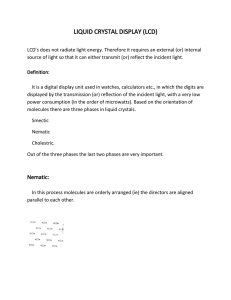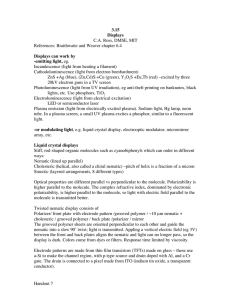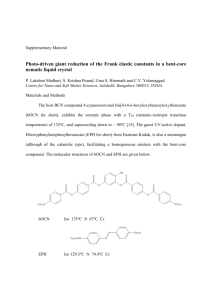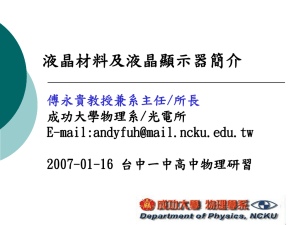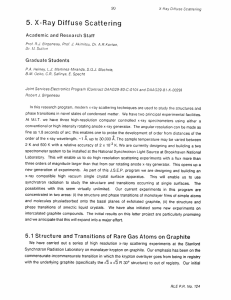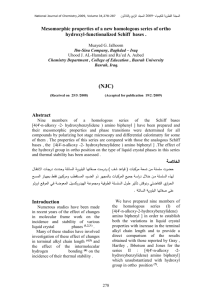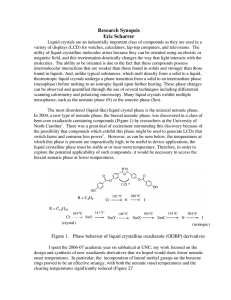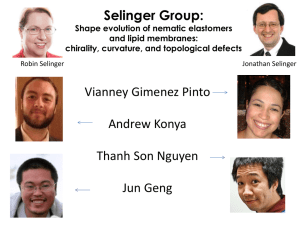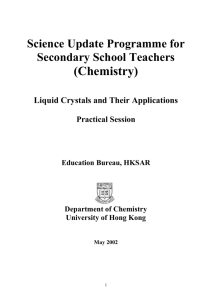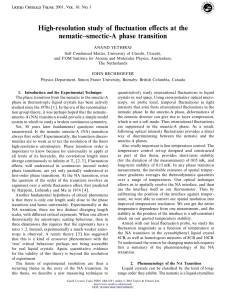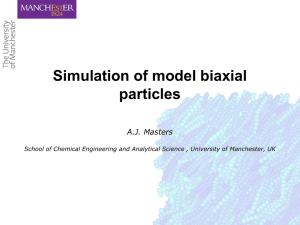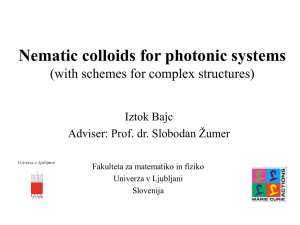Document
advertisement
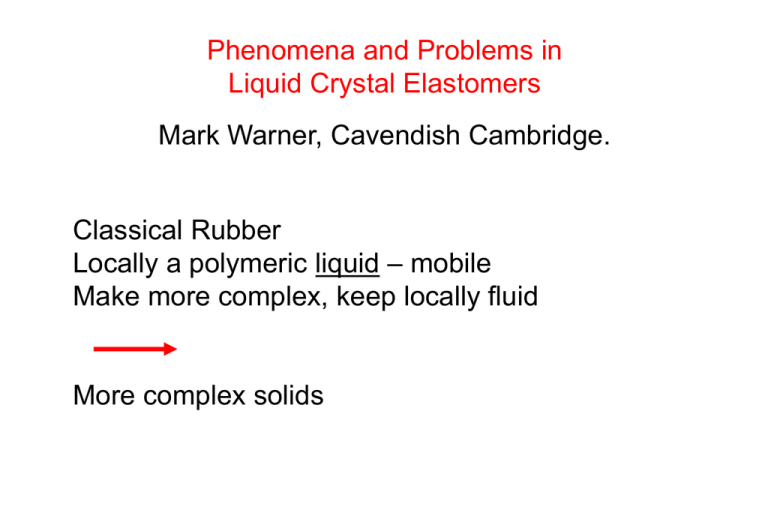
Phenomena and Problems in Liquid Crystal Elastomers Mark Warner, Cavendish Cambridge. Classical Rubber Locally a polymeric liquid – mobile Make more complex, keep locally fluid More complex solids Nematic fluid n cool Nematic polymers have shape anisotropy Crosslink: elastomers respond to molecular shape change monodomain Nematic Rubber n block of rubber l 1 R0 R Change shape with dT crosslink anisotropic chains 1 Fnem 12 Tr 0 initial shape T 1/ λ current shape μ ns RT ~ 105 J/m3 Roughly 300% strains. Temperature changed by hot air blower. Monodomain elastomer. Close to real-time movement. 2 Tajbakhsh and Terentjev Cavendish Laboratory Strain L/L0 3.5 3 2.5 Cross-section ~2mm2 2 1.5 1 20 40 60 80 100 Temperature ( C) 120 Load=15g Load=10g Load=5g No Load 6 Smectic liquids Nematic fluid with layered positional order. Layer modulus 107 N/m2. n (DJ Cleaver et al, Sheffield) k cool Smectic A Smectic C 2-D elastomer – layers so strong Spontaneous shears of smectic sheet (also possible with slab) (a) 25ºC (heating) (b) 90ºC (heating) (c) 130ºC qE qE LE LE (Hiraoka and Finkelmann, 2005) n k layers P Reduce order by bending some rods - Photo alternative to thermal disruption of order. Absorb photon into dye molecule trans isomer (straight) Recovery thermal or stimulated cis isomer (bent) Azo benzene Optical strains. Optical Can be very fast. Bend. Polydomain response. Thermal Non-uniform response Birubber strip, H Finkelmann, Freiburg. Nematic elastomer + green dye guest; laser pulse. Dye photoisomerises top has lower nematic order – differential photo-contraction??? Green laser pulse Palffy-Muhoray * Curvature of photo-beams very rich (2 neutral planes) * Optically write structures in films Photo-bending of sheets (Ikeda, Nature, 2003) E Most peculiar dynamics – why does it continue curling after eclipsing itself?! What should the photo-stationary shape be? Uncurling in the absence of UV. (in light – stimulated decay) Responsive surfaces and thin films light beam localised strains photo-rubber a H uz z uzzH l uzr urz r Substrate Elongation on illumination Rotate order rather than change magnitude Stretch transverse to director • Body accommodates ( ) rotating chain distribution. • Need shear & stretch. • Entropy, energy constant. thereafter hard. inscribed 1/ 2 ( ) Fnem Tr 0 1 2 T 1 ( ) 32 Stretch transverse to director 1/ 2 ( ) Minimised by (Olmsted): soft 1(/ 2) 01/ 2 force/area hard sin 1 r ( / 1 ) 2 1 r 1 ( / 1 ) 2 stretch Response by rotation pervades all LC elastomer mechanics Photo-bend also for polydomains – depends on light polarisation E 45o E k Light incident Curl direction ↔ light polarisation (heat a minor effect?) Polydomain photo-elastomer (thin) (MW & DC, PRL 06) Incident light Local molecular mobility Domains suffer director rotation away from E large change in natural shape 1 1 1 E Photo contraction l along E non-monotonic with intensity I recovered l, all domains isotropic 1.0 l back rotation complete 0.9 1+S director rotation gives strain 0.8 ~ I 0.7 0 2 NMR? Mechanics? Unpolarised light? 4 6 8 10 12 back rotation starts order parameter collapses (“bleaching”) in back-rotated domains SmC* ferro electric Spontaneous shear L ~ 0.4 Actuation based on shear. L k qn c p Ferro-electric films respond to: • stress/strain • electric field • light • heat Slab geometry for film Apply shear -2L Reverse polarisation Film bistable?? ^ k0 ^ n ^ qn 0 c^0 p^0 ^ k0 -2L ^ -c0 ^ p ^ z x^ Cholesterics – helically twisted nematics: Elastomers: Separate left from right handed molecules. Change colour on stretching. Lase when pumped – lasing colour changes with stretch . . . (tuneable laser from an elastic photonic band solid) Deformations in practice (Quasi-convexification) Replace gross deformations by microstructure of (soft) strains with lower energy which satisfies constraints in gross sense. Stripes Macroscopic extension (crossed polars) Kundler & Finkelmann Practical geometry – put stripes in where needed for lowest energy: (Depends on strip aspect ratio.) (soft) Conti et al (1/4 of strip) Zubarev, Finkelmann et al Terentjev et al Jump away from 0 ; global order S < 0 n q ~Q0 z 0 initially (and finally) z Q0 Jump back toward 0 n z q0 q~q0 Q~0 Detect by NMR? Collapse of local order Q; global order less negative Local and global order = 0 1.0 l 0.9 1+S 0.8 ~ I 0.7 0 2 4 6 8 10 12 Local order Q0 rotated away from E; global S<0 Mahadevan et al (Phys. Rev. Letts., 2004) Light intensity I(x) falls with x (absorption length d ) Contraction decreases with x Bending (curling) of beam or sheet thickness w>d: thick w<d: thin film rad. curvature Balance torques – get 2 neutral planes at depths xn Curvature (1/R) non-monotonic in d/w (absorption length/thickness) “thick” “thin” Optimal d ~ w/3 (more examples)
